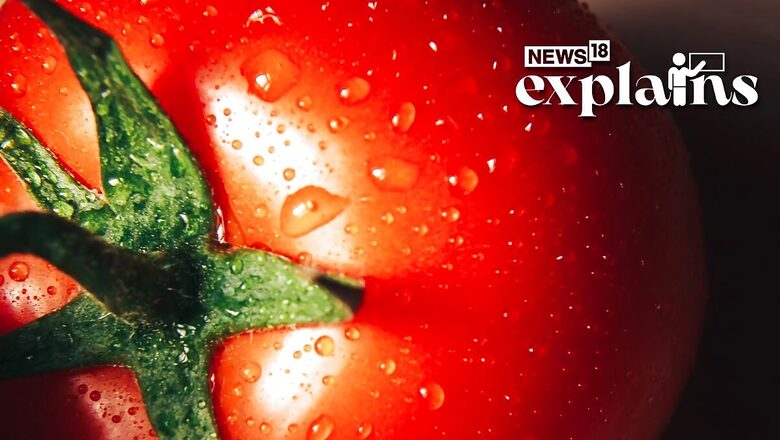
views
According to wholesalers, the prices of tomatoes and other vegetables have significantly risen in various parts of Rajasthan due to several factors, including heavy rainfall caused by the cyclonic storm Biparjoy. The wholesalers mentioned that tomato prices have increased four to five times as a result of the heavy rainfall from Biparjoy cyclonic activity, followed by the onset of the monsoon season, which has led to the destruction of farmers’ crops. They also stated that the prices of all vegetables have increased by one to two times.
Om Prakash Jain, a vegetable wholesaler in Muhana Mandi, Jaipur, told PTI that the local farmers’ produce was destroyed by the recent rains caused by the Biparjoy cyclonic activity, preventing it from reaching the local market. As a result, most vegetables, including tomatoes, are now being sourced from Bangalore, Nashik, Himachal Pradesh, Maharashtra, Uttar Pradesh, and Madhya Pradesh. Due to the influx of vegetables from outside the state, the prices have risen. For instance, tomatoes from Bangalore and Nashik are being sold at wholesale prices of Rs 60-65 per kg, and after factoring in taxes, commission, and wages, the cost reaches around Rs 80-85 per kg. In the retail market, tomatoes are being sold at Rs 100-120 per kg.
Another wholesaler mentioned that 15 days ago, green chilies were sold at Rs 3 per kg in the wholesale market, but the price has now increased to Rs 25 per kg. Similarly, bitter gourd, which was previously sold at Rs 8-10 per kg, is now available for Rs 25 per kg. The prices of lady finger, cabbage, ginger, lemon, ridge gourd, and round gourd, among other vegetables, have also increased significantly.
Moolchand, a vegetable retailer, stated that tomatoes, which were sold for Rs 20-25 per kg 15 days ago, are now priced at Rs 100-120 per kg. He also mentioned that the prices of other vegetables have doubled. The sudden surge in vegetable prices has impacted the household budgets of homemakers.
Bhawna Joshi, a homemaker, expressed concern about the soaring prices of tomatoes, stating that they have become unaffordable. This situation has affected their budget, forcing them to buy tomatoes in smaller quantities. Previously, tomatoes were used in salads, but now they are only used for making curry due to their high prices.
How Monsoons Figure In
Vegetable prices often rise when the monsoon season hits due to several reasons:
Crop Damage: Heavy rainfall during the monsoon can lead to waterlogging and flooding, which can damage crops and make them unfit for consumption or reduce their yield. This limited supply of vegetables leads to an increase in prices.
Disruption in Supply Chain: Monsoon rains can cause transportation and logistical challenges, making it difficult to transport vegetables from farms to markets. Roads may become impassable, and the overall movement of goods may be hindered. This disruption in the supply chain can reduce the availability of vegetables, causing their prices to rise.
Increased Demand: During the monsoon season, there is often an increased demand for certain vegetables that are essential for monsoon-specific dishes or are preferred during rainy weather. This higher demand can lead to price inflation as the available supply may not be sufficient to meet the increased consumption.
Dependency on Specific Regions: Some regions heavily rely on specific areas for the supply of certain vegetables. If those areas are adversely affected by the monsoon, such as experiencing crop damage or transportation issues, it can lead to a shortage in the market and subsequently higher prices.
Post-Harvest Losses: Excessive moisture during the monsoon season can lead to post-harvest losses as vegetables may spoil more quickly. This can further reduce the available supply and contribute to price hikes.
‘Hike is Temporary’
A senior government official has stated that the recent surge in tomato prices, with rates reaching Rs 100 per kg in major cities, is a temporary seasonal occurrence and prices will soon decrease. Consumer Affairs Secretary Rohit Kumar Singh explained that tomatoes are highly perishable, and transportation is affected in areas that experience sudden rainfall. He assured that this is a temporary issue that happens every year during this period. Singh pointed out that historical data from the past five years indicates that tomato prices tend to rise at this time, but they are expected to soften as the supply from Himachal Pradesh to Delhi begins in the next 10 days.
According to data from the Department of Consumer Affairs, the average price of tomatoes nationwide on June 27 was Rs 46 per kg. The mode price was Rs 50 per kg, while the maximum price reported was Rs 122 per kg. In major cities, retail prices for tomatoes were Rs 60 per kg in Delhi, Rs 42 per kg in Mumbai, Rs 75 per kg in Kolkata, and Rs 67 per kg in Chennai. In other cities, prices varied, with rates ranging from Rs 52 per kg in Bengaluru to Rs 99 per kg in Raipur.
In the Delhi-National Capital Region (NCR), tomato prices at Mother Dairy’s Safal stores doubled to nearly Rs 80 per kg within a week due to disrupted supplies caused by rains in key producing states. Mother Dairy stated that the crop was undergoing a seasonal transition due to the monsoon, and rainfall in areas like Himachal Pradesh and Uttarakhand had impacted the crop and limited its supply, resulting in a demand-supply gap.
Despite the current price situation, the Ministry of Consumer Affairs predicts that tomato prices are likely to remain lower in July, as per their artificial intelligence-based price prediction. The Secretary mentioned that prices in producing centers such as Madanapalle (Andhra Pradesh) and Kolar (Karnataka) are expected to decline in July compared to their present levels. Tomato production for the year 2022-23 is estimated to be slightly lower than the previous year, with a projected output of 20.62 million tonnes compared to 20.69 million tonnes.
In summary, the government official assures that the increase in tomato prices is temporary and seasonal, with prices expected to cool down soon.
PTI contributed to this report




















Comments
0 comment